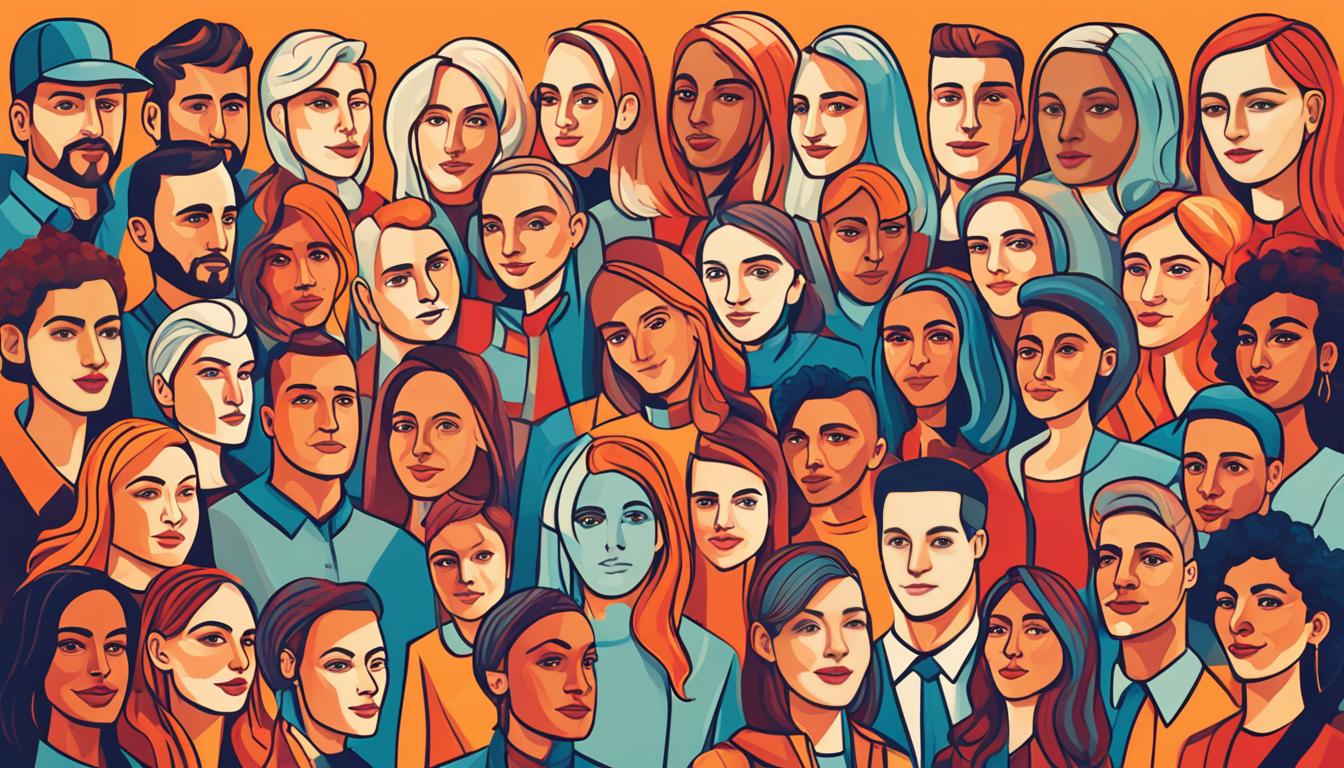Allyship is vital in creating inclusive organizations. A Deloitte study found it’s the “missing link” for workplaces where everyone feels valued. Allies drive positive change by advocating for marginalized groups and promoting diversity.
Effective allyship needs empathy, self-awareness, and a drive to learn and act. Allies must listen, understand underrepresented colleagues’ experiences, and stay updated on DE&I practices. They use their privilege to challenge bias and amplify marginalized voices.
Organizations prioritizing allyship show commitment to workplace diversity. This leads to higher employee engagement, better productivity, and improved talent retention. Employees who feel valued are more loyal, satisfied, and motivated.
Allyship creates a sense of community and safety. It allows diverse individuals to share unique ideas, boosting innovation and teamwork. This contributes to a more equitable and inclusive workplace.
Key Takeaways
- Allyship is a critical component in promoting diversity and inclusion in the workplace.
- Effective allies demonstrate empathy, self-awareness, and a commitment to ongoing learning and action.
- Organizations that prioritize allyship experience increased employee engagement, productivity, and retention.
- Allyship creates a sense of belonging and psychological safety, leading to greater innovation and collaboration.
- By advocating for change and amplifying underrepresented voices, allies contribute to a more equitable and inclusive workplace.
Understanding Allyship and Its Importance
Allyship is crucial for creating inclusive environments and advancing diversity initiatives. It involves building trust-based relationships with marginalized groups. This ongoing process requires consistency and accountability from allies.
Allyship isn’t self-defined. Instead, it’s recognized by those who receive support. It’s about using privilege to benefit underrepresented communities.
Definition of an Ally
An ally actively promotes inclusion through positive, conscious efforts. They recognize their privilege and use it to support underrepresented groups. Allies educate themselves on diversity issues and challenge bias.
They speak up against discrimination and work to change the status quo. Their actions benefit people as a whole, not just specific groups.
“Allyship is an opportunity to grow and learn about ourselves while building confidence in others.” – Unknown
The Significance of Allyship in Promoting Diversity and Inclusion
Allyship is vital for creating inclusive workplaces and advancing diversity initiatives. It helps amplify marginalized voices and contributes to a more equitable society. Allies break down barriers and challenge stereotypes.
They promote cultural competence and foster understanding between different groups. This leads to more inclusive and productive work environments.
| Statistic | Percentage/Ratio |
|---|---|
| Individuals who believe allyship is fundamental for advancing diversity and inclusion efforts in the workplace | 78% |
| Underrepresented groups who appreciate and value allies’ support in their professional environments | 4:5 |
| Companies providing training on diversity, equity, and inclusion, and unconscious bias | 68% |
| Leaders who have received ongoing coaching on leading inclusive teams | 45% |
| Companies reporting increased productivity due to fostering inclusive, equitable, and diverse workplaces | 72% |
Organizations can unlock their workforce’s full potential by promoting allyship and inclusive leadership. Diverse teams drive better business performance and innovation. They also increase a company’s resilience in changing markets.
As more people become allies, we move closer to a just society. Active allyship creates positive change in workplaces and communities alike.
Recognizing Privilege and Using It for Positive Change
Understanding privilege is key to becoming an effective ally for diversity and inclusion. Privilege varies based on multiple identities like race, gender, and socioeconomic status. It’s intersectional, meaning people can have different levels of advantage or disadvantage.
Acknowledging Intersectional Privilege
Recognizing your own privilege can be uncomfortable but is vital for creating inclusive environments. By examining different aspects of power, you can understand how your identities affect your experiences.
This process helps you see how privilege shapes opportunities. It’s a crucial step towards building a more equitable society.
- White individuals can acknowledge their racial privilege and work to dismantle systemic racism.
- Men can recognize their gender privilege and advocate for gender equality in the workplace.
- Cisgender and heterosexual individuals can use their privilege to support and amplify the voices of the LGBTQ+ community.
- Able-bodied individuals can leverage their privilege to create accessible spaces and advocate for disability rights.
- Economically privileged individuals can use their resources to support and uplift marginalized communities.
| Demographic | Average Dimensions of Power |
|---|---|
| White Straight Males | 10 out of 12 |
| Women of Color | Least amount of privileges |
| White Women | 9 out of 12 |
Leveraging Privilege to Amplify Underrepresented Voices
Once you recognize your privilege, use it to amplify underrepresented voices. Speak up when someone is marginalized. Advocate for others and promote diversity and inclusion best practices.
By using privilege for good, allies can create more equitable workplaces. This active approach helps build inclusive environments for everyone.
“Speaking up when someone is marginalized, advocating for others not like oneself, and using privilege for good are actions aspiring allies can take.” – The Role of Allyship in Advancing Diversity and Inclusion: Being an Advocate for Change
Organizations can support allyship through diversity training and employee resource groups. They can also implement practices that foster an inclusive culture. By recognizing privilege and using it positively, we can create a more just society.
Listening, Learning, and Educating Oneself
Effective allyship requires active engagement in listening, learning, and self-education. This process involves understanding underrepresented groups’ experiences and researching diversity topics. Staying informed about current events and best practices is also crucial.
Engaging in Active Listening and Seeking to Understand
Active listening is vital for allyship. It means giving full attention, asking clarifying questions, and showing empathy. A study on cultural competency in healthcare found high agreement on the need for cultural sensitivity.
By listening to underrepresented colleagues, allies gain valuable insights into their challenges. This understanding helps build stronger relationships and fosters a more inclusive environment.
“Listening is a magnetic and strange thing, a creative force. The friends who listen to us are the ones we move toward. When we are listened to, it creates us, makes us unfold and expand.” – Karl A. Menniger
Researching and Staying Informed on Diversity and Inclusion Topics
Effective allies stay informed about diversity and inclusion topics. This includes historical events, current issues, and best practices. Research shows that specific experiences can reduce implicit racial bias among medical students.
Actively seeking diversity case studies, metrics, and research deepens understanding. This knowledge equips allies to better advocate for change in their communities and workplaces.
| Diversity and Inclusion Initiative | Impact |
|---|---|
| Diversity, equity, and inclusion training for volunteers | Increased awareness and understanding of DEI issues |
| Removal of preferential treatment for legacies during recruitment | Promoted fairness and equal opportunity in the recruitment process |
| Workshops on social justice and racial justice | Enhanced member engagement and commitment to diversity and inclusion |
| Modifications to ceremonies for inclusivity purposes | Demonstrated organizational commitment to creating a welcoming environment for all members |
Allies build a strong foundation for advocating change through active listening and learning. Understanding diverse perspectives helps create more inclusive environments. This ongoing process is essential for promoting diversity and inclusion effectively.
Speaking Up and Challenging Bias
Allies must speak up against workplace bias and discrimination. Their support for those affected is crucial. Challenging bias creates a more inclusive environment and shows that such actions are unacceptable.
Supervisors and managers have a unique platform to practice amplification. They can use their privilege to ensure underrepresented voices are heard. Inclusive meeting practices can help achieve this goal.
Allies can invite diverse perspectives and credit ideas to their original contributors. This approach values different viewpoints and promotes fairness in the workplace.
“Allies must be willing to take risks and use their privilege to advocate for change. It’s not always easy, but it’s necessary for creating a more equitable and inclusive workplace.”
When allies make mistakes, they should acknowledge and apologize sincerely. Addressing underlying behaviors helps prevent future missteps. This commitment to growth fosters trust among colleagues.
Diversity and inclusion committees can guide allies to become better advocates. They provide resources and support for this important journey.
| Action | Impact |
|---|---|
| Speaking up against biased comments | Creates a more inclusive environment |
| Amplifying underrepresented voices | Ensures diverse perspectives are heard and valued |
| Acknowledging and apologizing for missteps | Demonstrates commitment to growth and learning |
Allies help create a fairer workplace by challenging bias. This benefits underrepresented groups and improves team performance. It also boosts innovation and creates a positive organizational culture.
As more people become allies, their impact grows. Together, they advance diversity and inclusion within organizations. This collective effort brings about meaningful change in the workplace.
Supporting and Advocating for Underrepresented Colleagues
Allyship involves actively supporting underrepresented colleagues at work. Allies use their privilege to create a more inclusive environment. They play a key role in fostering equity in the workplace.

Sponsoring and Championing Diverse Talent
Sponsorship means investing in and advocating for underrepresented individuals’ career advancement. Allies can sponsor diverse talent in several ways. They can recommend them for important projects and leadership roles.
- Recommending them for high-visibility projects and leadership positions
- Advocating for their promotions and career growth opportunities
- Connecting them with influential networks and decision-makers
Championing diverse talent helps break down systemic barriers. It ensures equal access to success for underrepresented individuals. Statistics show the importance of this support:
| Statistic | Implication |
|---|---|
| Only 3.2% of Fortune 500 CEOs are women | Underscores the need for allies to champion women’s leadership |
| Black and Latino employees make up just 16% of executives in tech | Highlights the lack of racial diversity in leadership positions |
| 40% of Power of Choice program participants reported being promoted | Demonstrates the impact of sponsorship on career advancement |
Providing Opportunities for Growth and Advancement
Allies can support underrepresented colleagues by offering growth opportunities. They can do this in several ways:
- Offering stretch assignments and challenging projects to help them develop new skills
- Nominating them for leadership development programs and training opportunities
- Providing visibility and recognition for their achievements and contributions
Nearly half of the respondents stated that the Power of Choice program helped them transition into a higher or more desirable position.
Investing in underrepresented talent creates a more diverse workplace. This support benefits both employees and organizations. Organizations with diverse workforces are 35% more likely to outperform those without diversity.
Allies play a crucial role in driving change. They advance diversity goals by advocating for diverse talent. Their actions help create a fair and inclusive workplace for everyone.
Fostering an Inclusive Work Environment
Creating an inclusive workplace requires commitment from leaders and employees. Allies promote inclusive language, behaviors, and diverse perspectives. This approach improves employee engagement, creativity, and overall performance.
Inclusive companies are more likely to lead in innovation and adaptability. Inclusive teams make better decisions faster than non-inclusive ones. Millennials report higher engagement when their workplace fosters inclusivity.
Promoting Inclusive Language and Behaviors
Allies use inclusive language and avoid gendered terms. They model inclusive behaviors like active listening and giving credit. Allies ensure equal opportunities for all team members to contribute.
Here are some key strategies for promoting inclusive language and behaviors:
- Use gender-neutral language in communication and documentation
- Avoid stereotypes and assumptions based on race, gender, age, or other characteristics
- Encourage open and respectful dialogue among team members
- Provide training on unconscious bias and inclusive communication
Encouraging Diverse Perspectives and Participation
Allies seek input from underrepresented voices in meetings and projects. They ensure all team members interact with clients and customers. Valuing diverse experiences drives innovation and improves customer service.
“Diversity is being invited to the party; inclusion is being asked to dance.” – Vernā Myers, diversity and inclusion expert
To encourage diverse perspectives and participation, allies can:
- Ensure equal speaking time and opportunities for all team members in meetings
- Assign work consistently and fairly, providing growth opportunities for everyone
- Seek feedback from diverse stakeholders when making decisions
- Celebrate and showcase the achievements of underrepresented colleagues
Leaders who value inclusion create an inclusive workplace. Tracking diversity metrics and developing strategies are crucial. Implementing action plans helps foster a culture where everyone feels valued.
| Inclusive Workplace Practices | Impact on Employee Engagement |
|---|---|
| Diverse workforce | 76% of job seekers consider it essential when evaluating job offers |
| Inclusive culture | 83% of millennials report higher engagement levels |
| Comprehensive anti-discrimination policies | 75% of respondents believe they are necessary to effectively tackle bias |
Engaging in Ongoing Learning and Self-Reflection
Effective allyship requires continuous learning and self-reflection. Allies must confront their biases, assumptions, and privileges to foster inclusivity. Regular self-reflection helps identify areas for growth, contributing to the organization’s diversity and inclusion ROI.
Recognizing and Addressing Personal Biases
Acknowledging personal biases is crucial for allies. Unconscious bias training helps recognize and mitigate these biases. A 2018 study of PR leaders revealed different self-reflection approaches between Russians and Americans.
The study involved 45-minute interviews with 30 PR leaders. It explored self-reflection practices in various organizational types. The findings stressed adapting strategies to cultural contexts and individual preferences.
Continuously Educating Oneself on Diversity and Inclusion Best Practices
Allies must stay updated on diversity and inclusion best practices. This includes attending workshops, reading relevant literature, and engaging in meaningful conversations. Continuous learning helps create a more inclusive workplace.
| Self-Reflection Tool | Details |
|---|---|
| Initial Questions | 47 questions, narrowed down to 38 with appropriate content validity and literature support |
| Pilot Administration | Resulted in excellent overall reliability, indicating the tool is psychometrically sound for self-reflection purposes |
| Recommended Usage | Pre-planning instruction or for mid or end of year reflections by teachers |
| Demographic Information | Primary place of employment, race, highest level of education, years in current position, years in the field, and previous training on diversity inclusion |
| Adapted From | Cultural Competence Self-Assessment Checklist and resources from the TeachAway platform |
A self-reflection tool can help allies assess their diversity awareness. The table above describes such a tool. It helps identify areas for improvement in supporting underrepresented colleagues.
Regular self-reflection and continuous learning are key. These practices enable allies to better support diverse colleagues. They also contribute to creating a more inclusive workplace culture.
Diversity & Inclusion: A Business Imperative
Diversity and inclusion drive business success. Companies embracing workplace diversity see increased innovation, creativity, and financial performance. A BCG study found diversity enhances innovation capacity and leads to better financial outcomes.
Gender diversity predicts future growth. Companies with diverse leadership generate more revenue from new products. Those with diverse management teams deliver higher EBIT margins.
Inclusive hiring builds diverse teams. Ernst & Young’s program to attract women resulted in 50% female senior ranks. Most CEOs in finance have diversity strategies.
Regulatory measures drive change. California Senate Bill 826 requires public companies to have women on boards. This addresses the lack of female representation in leadership.
Investing in diversity initiatives is crucial. This includes training budgets, community donations, and dedicated team members. Measuring DEIB culture emphasizes reporting and accountability.
Barely 35% of female millennials working in financial services believed they could rise to a senior level within their organizations.
| Enabling Factor | Description |
|---|---|
| Participative Leadership | Inclusive leaders who value and leverage diverse perspectives |
| Strategic Emphasis on Diversity | Diversity and inclusion as a core business strategy |
| Open Communication | Encouraging open dialogue and sharing of ideas |
| Culture of Openness to New Ideas | Fostering a culture that embraces and encourages diverse viewpoints |
| Fair and Transparent Employment Practices | Ensuring equitable opportunities for all employees |
Companies must create environments where diversity thrives. This allows the best ideas and practices to emerge. Diverse companies adapt better to external threats than homogenous ones.
Diverse workplaces turn small failures into learning opportunities. They apply various approaches to succeed in different settings. Diversity efforts must remain a top priority for business leaders.
Allyship in Action: Real-World Examples and Case Studies
Many organizations have successfully implemented diversity and inclusion initiatives through allyship. These examples show how allyship creates more inclusive workplaces. Let’s explore effective strategies for promoting diversity and inclusion through allyship.
Successful Diversity and Inclusion Initiatives Driven by Allyship
Companies have made great strides in diversity and inclusion by using allyship. Forté’s “Men as Allies” initiative grew from 10 to 41 business schools in just three years. This shows the growing importance of allyship in academic settings.
Johnson & Johnson’s LGBTQ Allyship Initiative has created a more inclusive workplace for LGBTQ+ employees. Kroger offers helpful allyship guides for supporting LGBTQ+ and Asian American Pacific Islander employees. Leidos has over 3,000 members across nine employee resource groups.
Microsoft made its global allyship program virtual and mandatory for all 160,000 employees in 2020. RingCentral and Google have also launched successful allyship programs. Google’s program focuses on antiracism through training workshops and speaker sessions.
Lessons Learned from Organizations Championing Allyship
These examples offer valuable lessons for organizations promoting diversity through allyship. It’s crucial to provide multiple opportunities for allyship and encourage employee engagement. This can include training workshops, speaker sessions, and resources on diversity and inclusion.
Allyship requires ongoing commitment and effort. Organizations must foster a culture of allyship by consistently promoting diversity initiatives. Recognizing allyship efforts and encouraging open dialogue are also important steps.
| Company | Allyship Initiative | Impact |
|---|---|---|
| Forté | “Men as Allies” initiative | Expanded from 10 to 41 business school campuses in 3 years |
| Johnson & Johnson | LGBTQ Allyship Initiative | Fostered a more inclusive workplace for LGBTQ+ employees |
| Kroger | Allyship guides for supporting LGBTQ+ and Asian American Pacific Islander employees | Provided effective resources for allyship |
| Leidos | Employee resource groups (ERGs) | Boasts over 3,000 members across nine ERGs |
| Microsoft | Global allyship program | Made virtual and mandatory for all 160,000 employees in 2020 |
Studying these successful allyship initiatives can provide insights into promoting workplace equity and inclusion. Applying these lessons can create a more supportive work environment. This can lead to increased innovation, creativity, and productivity.
Conclusion
Allyship is crucial for promoting diversity and inclusion in workplaces and beyond. Allies can create more equitable environments by recognizing privilege and listening to underrepresented voices. Companies with diverse leadership often achieve higher financial returns than their industry peers.
Diversity efforts help attract and retain talented employees from various backgrounds. Job seekers highly value diversity when considering job offers. Inclusive companies enjoy higher employee retention rates and increased loyalty.
Diverse teams excel in innovation, creativity, and decision-making. They outperform homogeneous groups in tasks requiring these skills. This diversity drives business success and fosters a more dynamic work environment.
Allies champion diversity by promoting inclusive language and behaviors. They engage in ongoing learning and self-reflection to become better advocates. Through collective efforts, we can create a more just world where everyone thrives.
FAQ
What is allyship and why is it important in promoting diversity and inclusion?
Allyship actively supports and advances change for marginalized groups. It focuses on inclusion, equity, and diversity. Allies help create an inclusive work environment where everyone feels comfortable being themselves.
This leads to increased trust, compassion, and productivity. Allyship is crucial for fostering a more inclusive and equitable workplace.
Who can be an ally and how can they leverage their privilege for positive change?
Anyone can be an ally because privilege is intersectional. White women can support people of color, men can support women, and cis people can support LGBTQI+ individuals.
Able-bodied people can be allies to those with different abilities. Economically privileged people can support those who are not. Allies use their privilege to amplify underrepresented voices and advocate for change.
What steps can allies take to educate themselves and better understand the experiences of underrepresented groups?
Effective allies engage in active listening, research, and education. They ask questions, seek to understand, and remain open to learning. Allies should research historical events and follow current news.
Joining social justice groups can broaden perspectives. Following diverse voices helps challenge biases. Learning effective communication is key to engaging with others.
How can allies speak up and challenge bias in the workplace?
Allies should address problematic behavior when they witness it. They should support the person affected by speaking up. Those in leadership positions can practice amplification and transfer benefits in the workplace.
If an ally makes a mistake, they should apologize sincerely and promptly. Addressing underlying behavior helps prevent future missteps.
What can allies do to support and advocate for underrepresented colleagues?
Allies can become sponsors for underrepresented colleagues. This supports career growth and increases company retention. Those with influence can recommend diverse individuals for key positions.
Advocating for underrepresented colleagues helps create a more inclusive workplace. It also promotes diversity in leadership roles.
How can allies foster an inclusive work environment?
Allies can use inclusive language and avoid gendered terms. They should encourage diverse perspectives in meetings and projects. Assigning work consistently ensures all team members have an active voice.
Creating opportunities for everyone to interact with clients is important. This helps build a more inclusive and equitable workplace culture.
What ongoing learning and self-reflection should allies engage in?
Effective allyship requires lifelong learning and self-reflection. Allies must recognize and address their own biases. They should continuously educate themselves on diversity and inclusion best practices.
Many companies offer diversity, equity, and inclusion training. Unconscious bias training is also beneficial for allies.
How can allyship drive successful diversity and inclusion initiatives in real-world examples?
Takeda, a global pharmaceutical company, provides a great example of allyship in action. Their Black Leadership Council (BLC) facilitates conversations on race, diversity, and inclusion.
The BLC promotes allyship, equity, and fair representation for employees of African ancestry. This initiative demonstrates how allyship can drive successful diversity and inclusion efforts.



